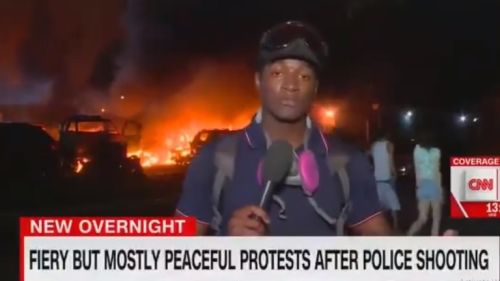Mostly peaceful
From The New CriterionSince last we met, the revolution foretold this time last year in these pages (see “Revolutionism redux” in The New Criterion of September, 2019) has reached its kinetic phase, as everyone except the media can plainly see. Actually, the media can see it too, but, acting on the time-honored Marxist-Leninist principle that “truth” is whatever serves the revolution, they find it expedient to deny that the active revolutionaries in the streets of several major cities are anything but “mostly peaceful” protesters. Who are you going to believe, them or your lying eyes? “Violent protests are not the story. Police violence is,” insisted Vox at the end of May, at the beginning of what we were not to call rioting, originally inspired by the death of George Floyd under the knee of policeman Derrick Chauvin in Minneapolis on Memorial Day. And the rest of the media took up the cry: “Two Crises Convulse a Nation: A Pandemic and Police Violence,” wrote Jack Healy and Dionne Searcey for The New York Times, echoing their colleagues Shaila Dewan and Mike Baker who reported that, “Facing Protests Over Use of Force, Police Respond With More Force.”
Clearly, in Times-world, “force” could only be predicated of the police and not the “mostly peaceful” protesters pelting them with rocks and frozen water bottles, among other things. The pretense that it was all about poor George Floyd and the now rich and powerful “Black Lives Matter” syndicate was kept up for weeks in the teeth of photos of largely white crowds carrying placards with a laundry list of left-wing desiderata and anti-Trump hate speech. Mr Trump, who was elsewhere when Mr Floyd was killed and did not approve of his killing, blamed the mob violence on Antifa — which the Times indignantly denied. There was, the paper claimed, “scant evidence” of Antifa’s involvement, though there was no indication that it had made the slightest effort to find any such evidence. The Washington Post repeated the formula the next day: “Scant evidence of antifa shows how sweeping the protests for racial justice have become,” wrote Isaac Stanley-Becker for the Post in mid-June.
At both papers and among their readership there was clearly a powerful will to believe something so preposterous as that the revolutionary mob which has been making sporadic appearances around the country (and rather more continuous ones in Portland) ever since it showed up at Mr Trump’s inauguration was giving the BLM protests a miss — self-isolating at home, perhaps, with jigsaw puzzles and board games. When Senator Tom Cotton wrote an op ed for the Times calling on the President to send in troops to put an end to the rioting and citing Antifa’s involvement, another revolt of the paper’s revolutionary cell which shook the throne of the nominal editor, Dean Baquet, last summer (see “Revolutionism redux, part II” in The New Criterion of October, 2019) led not only to the retraction of the article but the dismissal of its commissioning editor, James Bennet. The retraction cited the paper’s own reporting of Antifa’s non-involvement to justify itself and to discredit Senator Cotton.
By mid-July, when the President did send — not troops but federal law enforcement agents armed and dressed in combat gear to make them practically indistinguishable from soldiers — into Portland to protect federal buildings against arson and bomb attacks, the paper had changed tack. By then it was OK for the Times to report that Antifa was involved in the so-called protests — but only as a benign force, alongside the “moms” and “vets” who were defying this allegedly “militaristic” exercise of government power. “From Antifa to Mothers in Helmets, Diverse Elements Fuel Portland Protests” wrote Sergio Olmos, Rick Rojas and Mike Baker. Being certified as “diverse” was presumably even better than being “mostly peaceful” — the formula presently shortened by former President Obama at the funeral of Congressman John Lewis to merely “peaceful,” for brevity’s sake — and even seems to have given them an excuse to eschew peacefulness. The sub-head to Messrs Olmos, Rojas and Baker’s piece was: “Protesters have been in the streets for more than 50 consecutive days. Federal agents deployed to Portland have hardened their resolve to stay there.” Once again, in other words, any rioting that might or might not be going on in Portland was not to be supposed the fault of the rioters but of the most tentative of efforts to suppress them.
The next day, Times reporters Peter Baker, Zolan Kanno-Youngs and Monica Davey sought to alarm readers by notifying them that “Trump Threatens to Send Federal Law Enforcement Forces to More Cities.” Threatens? Since when is enforcement of the law considered threatening by the law-abiding in America? I’m afraid there is an answer to that question. It’s since the revolutionary left emerged to put law-abiding out of fashion, at least among the cultural and political elites of the media and the deep state. Disregard for the law has long been axiomatic in these quarters, but hitherto it has been thought politic not to be too public about it. Since the murder of George Floyd and the re-emergence of Black Lives Matter, however, even mainstream Democratic politicians, in theory answerable to voters, have become very public about their contempt for the law — at least for any law Donald Trump proposes to enforce. The photo of Nancy Pelosi and congressional Democrats, all draped in kente cloth and kneeling in homage to a lawless mob in Washington D.C. would once have been thought political suicide. It apparently is so no longer.
The subhead to the article by Peter Baker et al., mentioned above, is this: “As federal agents patrol Portland and head to Chicago, Democrats call the president’s plan ‘an American crisis,’ barely 100 days before the election.” Ah, yes. The election. With Joe Biden holed up in his basement and speaking only to friendly interlocutors, we’d almost forgotten about that. But just as the Democrats were no longer afraid to advertise their sympathy with lawlessness, so their media allies were apparently becoming at least a little more forthright about the political motivation behind their strategy for reporting on it. Not that that strategy hasn’t been pretty obvious hitherto. On the morning that this is written, near the end of July, the second top story in the Washington Post’s Headlines e-mail reads as follows: “‘It was like a kidnapping’: Viral video shows NYPD officers forcing protester into unmarked van.” The story which follows, by Allyson Chiu (later updated with the help of Shayna Jacobs), follows up the whiff of scandal in the headline about what might otherwise have seemed a routine arrest for vandalism:
When an unmarked Kia minivan screeched to a stop near protesters marching in Manhattan on Tuesday evening, the demonstrators’ surprise swiftly gave way to alarm. Several New York Police Department officers wearing T-shirts and shorts spilled out of the van and grabbed one of the protesters, dragging her toward the vehicle, according to videos filmed by bystanders. The videos of the chaotic scene, which bore a marked similarity to the controversial tactics used by federal officers to detain demonstrators in Portland, Ore., quickly went viral. Protesters who witnessed the incident described it as a “kidnapping,” while a number of New York’s elected officials, including Rep. Alexandria Ocasio-Cortez (D-N.Y.), decried the officers’ actions and demanded further explanations from the NYPD. “Our civil liberties are on brink [sic]. This is not a drill,” Ocasio-Cortez tweeted. “There is no excuse for snatching women off the street and throwing them into unmarked vans.”
In other words, it was the protesters’ version of what was going on, and that of such sympathizers as Ms Ocasio-Cortez, which was given pride of place in the story, along with Ms Chiu’s helpful link to the media’s narrative about arrests of “protesters” in Portland. Only then did we get any indication of what the arrest was for or why it was carried out in this way. The suspect, one Nikki (or Nicki) Stone, was “wanted for damaging police cameras during 5 separate criminal incidents in & around City Hall Park,” said the police, who also claimed to have come under assault from protesters throwing rocks and bottles during the arrest. Ms Chiu was as skeptical of the police account of the incident, as she was credulous about the protesters’, and the article was later re-written to lead with Mayor DeBlasio’s condemnation of the police. “De Blasio (D) said that, while it was proper to arrest a person suspected of damaging city property, this was ‘the wrong time and the wrong place to effectuate that arrest.’” Hizzonor then went on to repeat and reinforce the article’s comparison with Portland. “A lot of us have watched in pain what’s been going on in Portland, Oregon, and the fact [is] that you see federal agents, federal officers, federal troops, clearly doing inappropriate things meant to undermine our democratic process.” Clearly, he and his media allies both regard it as now well-established that arresting anybody for anything, at least when “protests” are going on, is “inappropriate” and anti-democratic.
There is of course no mention of the numerous assaults on the police in Portland or the arson attacks and bomb-throwing at the federal court house there. It is only the actions of the police and federal agents which are of interest to the media, and only those to the extent that they reinforce the master narrative, set out for them by Vox two months earlier, that “Violent protests are not the story. Police violence is.” Notice that Vox didn’t say there were no violent protests; only that they weren’t “the story” — aka the narrative. We have been warned. The media are no longer interested in and will not report anything — no matter its truth or its salience for an understanding of what is really going on — which does not fit their narrative.
The rationale for such a blatantly partial and partisan approach to the news was hinted at towards the end of Ms Chiu’ Washington Post piece when she noted that Manhattan Borough President Gale A. Brewer “urged the police to remember the importance of de-escalation.” Now readers should know that “de-escalation” is a jargon term borrowed from the lately established academic discipline of “peace studies” or “conflict avoidance” and ultimately from the Johnson administration’s disastrous conduct of the Vietnam war, based on escalation or de-escalation of force against the enemy in a vain attempt to make him come to terms. The word now signifies the well-established but plainly erroneous axiom that, if you’re nice to people who intend violence against you, they’ll be nice to you instead.
It would be hard to exaggerate the naiveté of such an idea, which is no doubt why it must be disguised with the pseudo-technical language of “de-escalation.” But it is exactly that foolish principle which lies behind the contention that, if any violence is done to the police, it can only be, ex hypothesi, as an inevitable consequence of violence done by the police. That’s why the latter must be, in Vox’s words, “the story” and not the former. It’s also the reason for all the media complaints about the “militarized” police: if you come to a riot expecting to have to fight — some would say a pretty reasonable expectation — that must count as a provocation to the rioters to (in the words of The New York Times) “harden their resolve.” Law-enforcement’s “threat” of resistance to criminal acts can only lead to more criminal acts. Some such process of reasoning must have been going on in the addled pate of Congressman Jerry Nadler when he called the Portland riots “a myth that’s being spread only in Washington, D.C.”
Admittedly, Congressman Nadler has never been accused of being the brightest bulb on the Democratic Christmas tree, but he was only following in the footsteps of his leader, Speaker of the House Nancy Pelosi, when she called the federal agents trying to enforce the law in Portland “storm troopers” — which was only the latest of her counter-factual assertions presented as truth. Neither she nor Congressman Nadler can “really” believe such things or they would be clinically insane. But the key to understanding them is in that word “really.” They have absorbed the central insight of the postmodern intellectual, which is that, if any particular “reality” doesn’t suit you, you only need to put quotation marks around it in order to indicate that your superior brainpower has discerned it to be not reality at all but a mere “social construction” badly in need of deconstructing. In the brave new world of the “woke,” reality is fungible.
This is to say that, in the intellectual’s view — and now also in that of the Democratic party and the media — reality can only be determined by their ideology, so that anything that doesn’t fit with that ideology can’t be real. They have taught themselves to think they have a right to their own reality because they have made the a priori judgment that, as Barack Obama used to say, they are on “the right side of history.” The course of history is already known to them, thanks to their ideology, which cannot be wrong — and so neither can they. This self-certainty is also what is behind the “cancel culture” that has lately claimed many more victims than James Bennet. As John Stuart Mill wrote more than a century and a half ago: “To refuse a hearing to an opinion, because they are sure that it is false, is to assume that their certainty is the same thing as absolute certainty. All silencing of discussion is an assumption of infallibility.” But can the Democrats and the media possibly be right in thinking that they will pay no price for publishing so much patent falsehood, and that a majority of Americans are prepared to believe that the rioters, looters and arsonists are the good guys (they include a “wall of moms” after all!) while law enforcement, federal, state and local, are the bad guys? It may be so. We shall find out in November — or, if the Democrat campaign for mail-in voting is successful, probably some time next year during the presidency of Nancy Pelosi — who by law would assume that office if the election result were not known by January 20, 2021.
In the absence of any Democratic politician’s condemnation of the rioters, it is hard for me to see how anyone can vote for Joe Biden — or any Democrat — not knowing that it is also a vote for the Antifa mob and the cancel culture. Four years ago, Democratic “sanctuary cities” and a judiciary and a deep state ever more inclined to make up the law as it goes along did not loom so large in ordinary people’s consciousness that they would automatically have identified the Democrats as the party of lawlessness and arbitrary rule. I don’t think that can be the case today, with the mob on the streets of Portland and Seattle and other Democrat-dominated cities. Can there then be a majority of ordinary people on the side of lawlessness and arbitrary rule? All the instruments at our disposal to measure such things seem to suggest that there is. Therefore, either the instruments are wrong, even more spectacularly than they were in 2016, or America is now substantially pro-Revolution for the first time since 1776. As there is more recent precedent for the instruments’ being wrong, and as it seems unlikely that the country can have changed so much so quickly, I’m putting my money on another Republican victory. Of course, I don’t pretend to be infallible.
Discover more from James Bowman
Subscribe to get the latest posts to your email.







